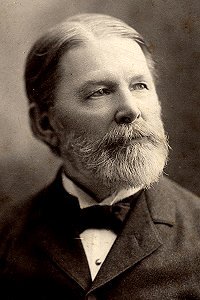Shall We Gather at the River is perhaps, without question, the most popular of his songs. Of this Mr. Lowry said: It is brass band music, has a march movement, and for that reason has become popular, though for myself I do not think much of it.
Yet he tells us how, on several occasions, he had been deeply moved by the singing of that hymn.
“Going from Harrisburg [Pennsylvania] to Lewisburg once I got into a [train] car filled with half-drunken lumbermen. Suddenly one of them struck up Shall We Gather at the River?
and they sang it over and over again, repeating the chorus in a wild, boisterous way.
“I did not think so much of the music then as I listened to those singers, but I did think that perhaps the spirit of the hymn, the words so flippantly uttered, might somehow survive and be carried forward into the lives of those careless men, and ultimately lift them upward to the realization of the hope expressed in my hymn.
“A different appreciation of it was evinced during the Robert Rakes’ Centennial. I was in London, and had gone to meeting in the Old Bailey to see some of the most famous Sunday school workers in the world. They were present from Europe, Asia, and America. I sat in a rear seat alone.
“After there had been a number of addresses delivered in various languages, I was preparing to leave, when the chairman of the meeting announced that the author of ‘Shall We Gather at the River?’ was present, and I was requested by name to come forward.
Men applauded and women waved their handkerchiefs as I went to the platform. It was a tribute to the hymn; but I felt, when it was over, that, after all, I had perhaps done some little good in the world, and I felt more than ever content to die when God called.
Hall, pp. 74–75
The year after [this song] was written, on Children’s Day, in Brooklyn [New York], when the assembled Sunday-schools of the city met in bewildering array, this song was sung by more than forty thousand voices. There was not a child from the gutter or a mission waif who did not know it.
An American lady writing from Cairo, who was allowed to visit the military hospital soon after some wounded men had been brought in from a skirmish, says: “The three hours we could stay were full of work for heart and hand.
“One young soldier from a Highland regiment especially excited my interest. He had lost a limb, and the doctor said he could not live through the night.
“I stopped at his side to see whether there was anything that I could do for him. He lay with closed eyes; and as his lips moved I caught the words, ‘Mother, mother.’ I dipped my handkerchief in a basin of iced water, and bathed his forehead where the fever flushes burned.
“‘Oh, that is good!’ he said, opening his eyes. Seeing me bending over him, he caught my hand and kissed it. ‘Thank you, lady,’ he said; ‘it ’minds me o’ mother.’
“I asked him if I could write to his mother. ‘No,’ he said; the surgeon had promised to write; but could I, would I, sing to him? I hesitated a moment, and looked around. The gleam on the yellow water of the Nile, as the western rays slanted down, caught my eye and suggested the river the streams of which shall make glad the city of God.
“I began to sing in a low voice the gospel hymn, ‘Shall we gather at the river?’ Eager heads were raised around us to listen more intently, while bass and tenor voices, weak and tremulous, came in on the chorus,—
‘Yes, we’ll gather at the river,
The beautiful, the beautiful river;
Gather with the saints at the river
That flows by the throne of God.’
“When the song was ended, I looked into the face of the boy—for he was not over twenty—and asked, ‘Shall you be there?’
“‘Yes, I’ll be there, through what the Lord Jesus has done for me,’ he answered, with his blue eyes shining, while a ‘light that never was on sea or land’ irradiated his face.
“The tears gathered in my eyes as I thought of the mother, in her far-off Scottish home, watching and waiting for tidings of her soldier boy, who was breathing away his life in an Egyptian hospital.
Come again, lady, come again,
I heard on all sides as we left the barracks. I shall go; but I shall not find my Scottish laddie, for by to-morrow’s reveille he will have crossed the river.
Sankey, pp. 133–35

![]()
![]() ).
).
 )
)